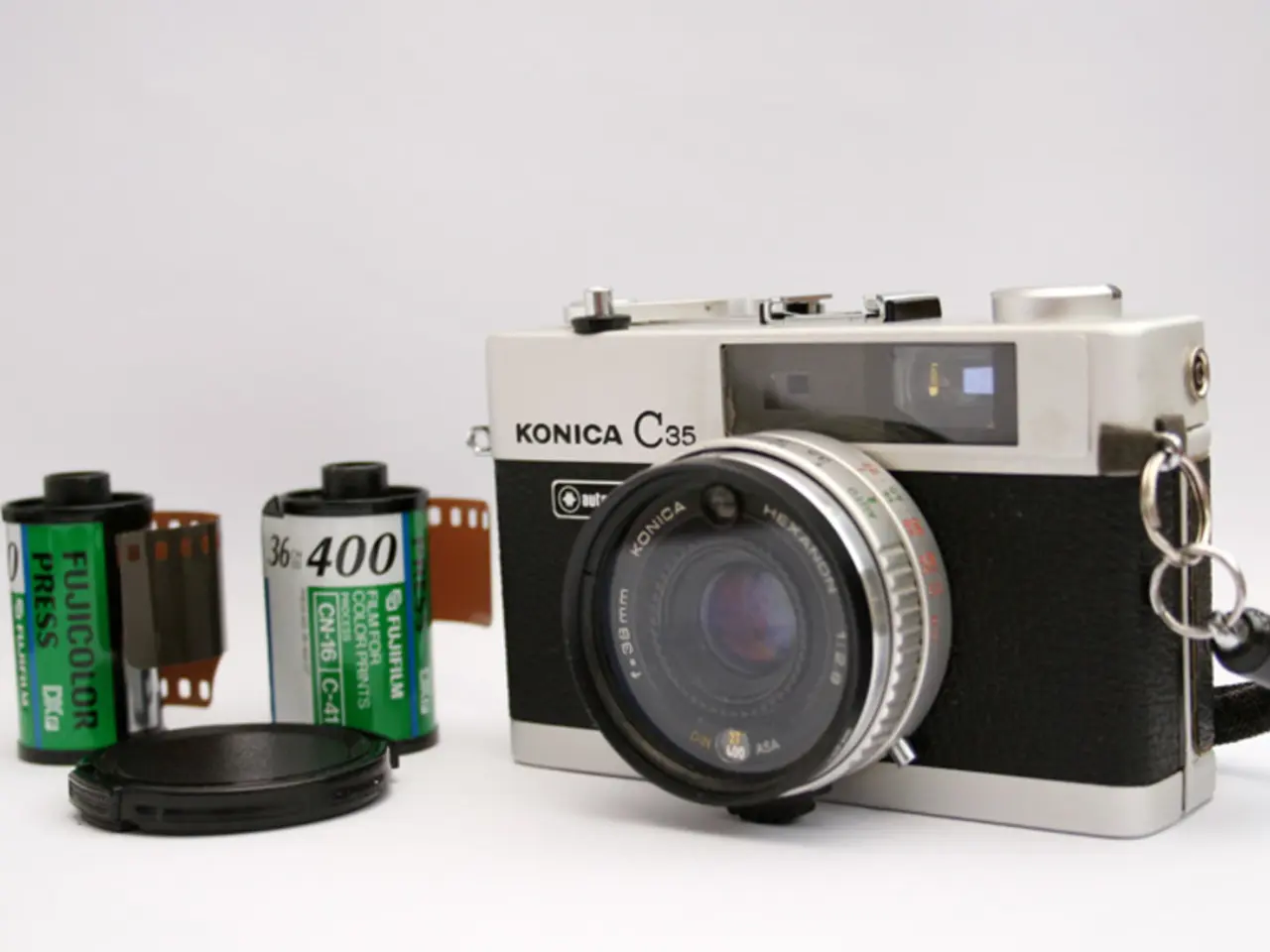Mirrorless camera Fujifilm X-M5 at last fulfills its compact vow, setting a new standard.
The Fujifilm X-M5, the latest addition to Fujifilm's X-Series, is making waves in the mirrorless camera market. This teeny tiny powerhouse combines high image quality, advanced video capabilities, and a compact design, setting it apart from competitors like the Nikon Z50 II, Canon EOS R10, and Sony A6400.
Key Features and Advantages of the Fujifilm X-M5
Sensor and Image Quality
The X-M5 boasts a 26.1MP APS-C sensor that excels at capturing detail and performs well in low light. The mirrorless design allows for a larger sensor, capturing more light and detail compared to many smaller mirrorless cameras, resulting in superior image quality.
Video Capabilities
The X-M5 offers advanced video features such as 6.2K video recording, 4K up to 60fps, 10-bit 4:2:2 internal recording, and even 6K open gate video. These features provide greater creative flexibility and cropping in post-production, giving it a significant edge in video versatility over cameras like the Nikon Z50 II and Canon EOS R10.
Autofocus and Subject Tracking
The camera automatically recognizes and tracks subjects efficiently, making it easier to maintain sharp focus across various shooting scenarios.
Compact and Lightweight Design
The X-M5 is Fujifilm’s smallest and most affordable X-series camera, offering high-end features in a very portable package. Its compactness competes well against other small mirrorless cameras like the Sony A6400 and Nikon Z50 II.
Ergonomics and Control
Fujifilm is known for tactile, analog-style controls that appeal to photographers, and the X-M5 continues that tradition. It has a fully tilting touchscreen LCD for flexibility in framing and menu navigation, supporting formats ideal for social media (square and vertical shooting).
Film Simulation Modes
Unique to Fujifilm, the X-M5 includes film modes such as Classic Chrome, Provia, and Astia, replicating the look of analog film, which can reduce the need for post-processing and give images distinctive color profiles.
Image Stabilization and Lens Ecosystem
While the X-M5’s kit (XC 15-45mm OIS) offers optical image stabilization for sharper shots, Fujifilm’s broader lens lineup, especially the premium XF lenses, are highly regarded for their quality and variety. This advantage often outclasses APS-C systems with fewer native lens choices like Nikon’s Z-mount APS-C system.
Comparison with Competitors
| Feature | Fujifilm X-M5 | Nikon Z50 II | Canon EOS R10 | Sony A6400 | |--------------------------|-------------------------------------|-------------------------------------|----------------------------------|--------------------------------| | Sensor Resolution | 26.1MP APS-C | 20.9MP APS-C | 24.2MP APS-C | 24.2MP APS-C | | Video | 6.2K video, 4K 60fps, 10-bit 4:2:2 | 4K video (30fps max) | 4K video (up to 60fps) | 4K video (30fps max) | | Autofocus | Advanced subject detection & tracking | Good AF performance | Good Dual Pixel AF | Fast hybrid AF | | Image Stabilization | OIS in lens, no IBIS on body | No IBIS | No IBIS | No IBIS | | Build and Ergonomics | Compact, retro controls | Lightweight, good grip | Compact, good controls | Compact, but somewhat utilitarian | | Unique Features | Film simulations, 6K open gate video | Strong RAW processing capabilities | Dual Pixel FFT, good video AF | Excellent AF for moving subjects | | Lens Ecosystem | Strong native prime & zoom lenses | Limited APS-C Z-mount lenses | Growing RF-S lens line | Extensive E-mount lenses |
In summary, the Fujifilm X-M5 stands out for its combination of high image quality, exceptional video specs, excellent subject tracking autofocus, and classic Fujifilm film simulations in a compact, user-friendly body. Its ergonomic design and retro control style also differentiate it in a crowded APS-C mirrorless market.
A Second Chance for the Fujifilm X-M5
Initially, the Fujifilm X-M5 might seem like a rehash of previous X-Series models in a retro design. However, with its impressive specs and compact size, it's worth another look, especially for hybrid shooters seeking quality photos and advanced video capabilities in a portable package.
Even those who miss optical viewfinders in DSLRs, like photography expert Mike Harris, might find themselves drawn to the X-M5's unique features and advantages. Harris, who has written for various publications including Digital Camera, PhotoPlus: The Canon Magazine, Practical Photography, Digital Photographer, iMore, and TechRadar, and has worked on Wex Photo Video's award-winning content team and as Technique Editor (later Deputy Editor) on N-Photo: The Nikon Magazine, has expressed his interest in the Fujifilm X-M5 after giving it a second chance.
- The Fujifilm X-M5's 26.1MP APS-C sensor is adept at capturing detail and performs well in low light due to the mirrorless design that allows for a larger sensor, capturing more light and detail compared to many smaller mirrorless cameras.
- The X-M5 offers advanced video features such as 6.2K video recording, 4K up to 60fps, and 10-bit 4:2:2 internal recording, providing greater creative flexibility and cropping in post-production.
- The camera automatically recognizes and tracks subjects efficiently, ensuring sharp focus across various shooting scenarios.
- Fujifilm’s X-M5 is its smallest and most affordable X-series camera, offering high-end features in a compact package, competing well against other small mirrorless cameras.
- The X-M5 has a fully tilting touchscreen LCD for flexibility in framing and menu navigation, supporting formats ideal for social media (square and vertical shooting).
- Unique to Fujifilm, the X-M5 includes film modes such as Classic Chrome, Provia, and Astia, replicating the look of analog film, which can reduce the need for post-processing and give images distinctive color profiles.
- While the X-M5’s kit offers optical image stabilization for sharper shots, Fujifilm’s broader lens lineup, especially the premium XF lenses, are highly regarded for their quality and variety.
- Photography expert Mike Harris, who has written for various publications, has expressed his interest in the Fujifilm X-M5 after giving it a second chance, despite missing optical viewfinders typically found in DSLRs.




